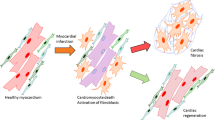Summary
Different models of isolated cardiomyocytes are generally used for biochemical, biophysical, and pharmacological studies. Fetal cardiomyocytes can be easily cultured for several weeks regaining their ability for rhythmical and synchronous contractions. For investigations, differentiated myocytes derived from adult hearts are closer to the in situ situation. Unfortunately, these cells at best exhibit irregular and asynchronous contractions at very low frequencies. Already 1 d after seeding calcium-tolerant rod-shaped adult cardiomyocytes on a suitable substrate, the differentiated cells begin to dedifferentiate forming a confluent monolayer. After 7–10 d their beating activities are like those of fetal cells. Therefore, we tried to combine the advantages of both cell types to achieve fully differentiated cardiomyocytes, rod-shaped and rhythmically beating, isolated from adult hearts. Using contractile fetal cells as a substrate for the adult cardiomyocytes, freshly seeded differentiated adult myocytes are paced by the contraction frequency of the fetal monolayer. As a consequence, the rod-shaped adult cardiomyocytes reach frequencies of more than 140 cycles/min without external electrical stimulation. This model enables us to study cardiomyocytes in a state very similar to the in situ situation with respect to morphology, integrity, and contractile behavior.
Similar content being viewed by others
References
Arrio-Dupont, M.; De Ney, D. Compartmentation of high-energy phosphates in resting and beating heart cells. Biochim. Biophys. Acta 851:249–256; 1986.
Bhatti, S.; Zimmer, G.; Bereiter-Hahn, J. Enzyme release from chick myocytes during hypoxia and reoxygenation: dependance on pH. J. Mol. Cell. Cardiol. 21:995–1008; 1989.
Claycomb, W. C. Long-term culture and characterization of the adult ventricular and atrial cardiac muscle cell. Basic Res. Cardiol. 80:171–174; 1985.
Eid, H.; Larson, D. M.; Springhorn, J. P., et al. Role of epicardial mesothelial cells in the modification of phenotype and function of adult rat ventricular myocytes in primary coculture. Circ. Res. 71:40–50; 1992.
Entman, M. L.; Youker, K.; Shappell, S. B., et al. Neutrophil adherence to isolated adult canine myocytes. J. Clin. Invest. 85:1497–1506; 1990.
Eppenberger, M. E.; Hauser, I.; Baechi, T., et al. Immuno-cytochemical analysis of the regeneration of myofibrils in long-term cultures of adult cardiomyocytes of the rat. Dev. Biol. 130:1–5; 1988.
Ganote, C. E.; Nayler, W. G. Contracture and the calcium paradox. J. Mol. Cell. Cardiol. 17:733–745; 1985.
Geisbuhler, T. P.; Rovetto, M. J. Lactate does not enhance anoxia/reoxygenation damage in adult rat cardiac myocytes. J. Mol. Cell. Cardiol. 22:1325–1335; 1990.
Gilbert, S. F.; Migeon, B. R.d-valine as a selective agent for normal human and rodent epithelial cells in culture. Cell 5:11–17; 1975.
Horackova, M.; Mapplebeck, C. Electrical, contractile, and ultrastructural properties of adult rat and guinea-pig ventricular myocytes in long-term primary cultures. Can. J. Physiol. Pharmacol. 67:740–750; 1989.
Isenberg, G.; Klöckner, U. Calcium tolerant ventricular myocytes prepared by preincubation in a “KB medium”. Pflügers Arch. 395:6–18; 1982.
Jacobson, S. L.; Banfalvi, M.; Schwarzfeld, T. A. Long-term primary cultures of adult human and rat cardiomyocytes. Basic Res. Cardiol. 80:79–82; 1985.
Libby, P. Long-term culture of contractile mammalian heart cells in a defined serum-free medium that limits non-muscle cell proliferation. J. Mol. Cell. Cardiol. 16:803–811; 1984.
Löw, I.; Friedrich, T.; Schoeppe, W. Synthesis of shock proteins in cultured fetal mouse myocytes. Exp. Cell Res. 181:451–459; 1989.
Marino, T. A.; Kuseryk, L.; Lauva, I. K. Role of contraction in the structure and growth of neonatal rat cardiocytes. Am. J. Physiol. 253:H1391-H1399; 1987.
Neyses, L.; Vetter, H. Isolated myocardial cells: a new tool for the investigation of hypertensive heart disease. J. Hypertens. 8:S99-S102; 1990.
Pelzer, D.; Cavalie, A.; Trautwein, W. Cardiac calcium channel currents at the level of single cells and single channels. Basic Res. Cardiol. 80:65–70; 1985.
Piper, H. M. Isolierte adulte Herzmuskelzellen als Myokardmodell. Stuttgart, Germany: Georg Thieme Verlag; 1985:37.
Piper, M.; Jacobsen, S. T.; Schwartz, P. Determinants of cardiomyocyte development in long-term primary culture. J. Mol. Cell. Cardiol. 20:825–835; 1988.
Rappaport, L.; Samuel, J. L. Microtubules in cardiac myocytes. Int. Rev. Cytol. 113:101–143; 1988.
Riehle, M.; Bereiter-Hahn, J. Ouabain and digitoxin as modulators of chick embryo cardiomyocyte energy metabolism. Drug Res.; in press.
Schlage, W. K.; Bereiter-Hahn, J. A microscope perfusion respirometer for continuous respiration measurement of cultured cells during microscopic observation. Microsc. Acta 87:19–34; 1983.
Schwartz, P.; Piper, H. M.; Spahr, R., et al. Development of new intercellular contacts between adult cardiac myocytes in culture. Basic Res. Cardiol. 80:75–78; 1985.
Spahr, R.; Piper, H. M.; Schwartz, P., et al. Morphological dedifferentiation of adult cardiac myocytes in coculture with hepatocytes. Basic Res. Cardiol. 80:83–86; 1985.
Volz, A.; Piper, H. M.; Siegmund, B., et al. Longevity of adult ventricular rat heart muscle cells in serum-free primary culture. J. Mol. Cell. Cardiol. 23:161–173; 1991.
Weisensee, D.; Bereiter-Hahn, J.; Schoeppe, W., et al. Effects of cytokines on the contractility of cultured cardiac myocytes. Int. J. Immunopharmacol. 15:581–587; 1993.
Yazawa, K.; Kaibara, M.; Ohara, M., et al. An improved method for isolating cardiac myocytes useful for patch-clamp studies. Jpn. J. Physiol. 40:157–163; 1990.
Author information
Authors and Affiliations
Additional information
An abstract of this article was previously published in Eur. J. Cell Biol. 57 (Suppl.36): 86; 1992.
Rights and permissions
About this article
Cite this article
Weisensee, D., Seeger, T., Bittner, A. et al. Cocultures of fetal and adult cardiomyocytes yield rhythmically beating rod shaped heart cells from adult rats. In Vitro Cell Dev Biol - Animal 31, 190–195 (1995). https://doi.org/10.1007/BF02639433
Received:
Accepted:
Issue Date:
DOI: https://doi.org/10.1007/BF02639433




